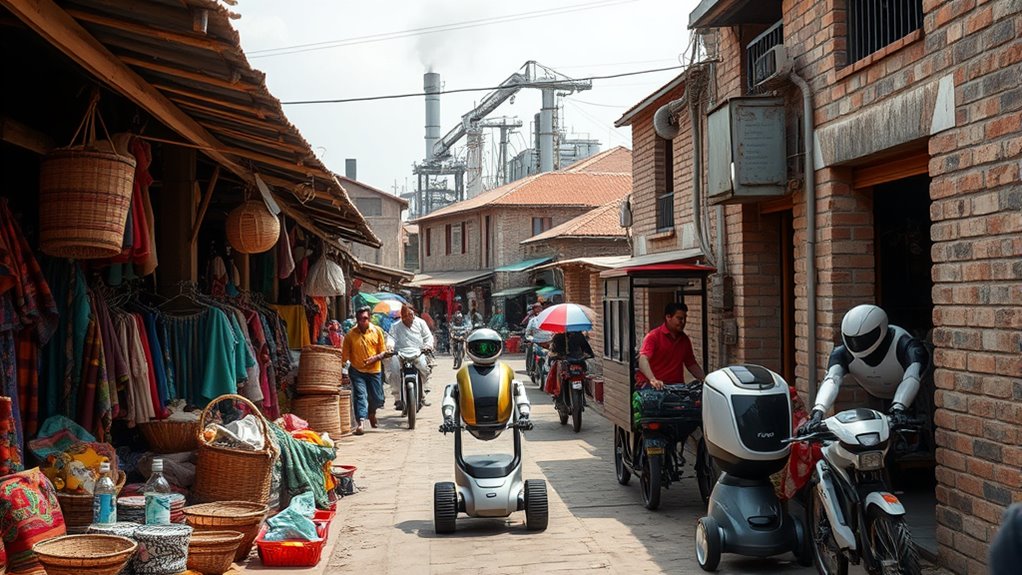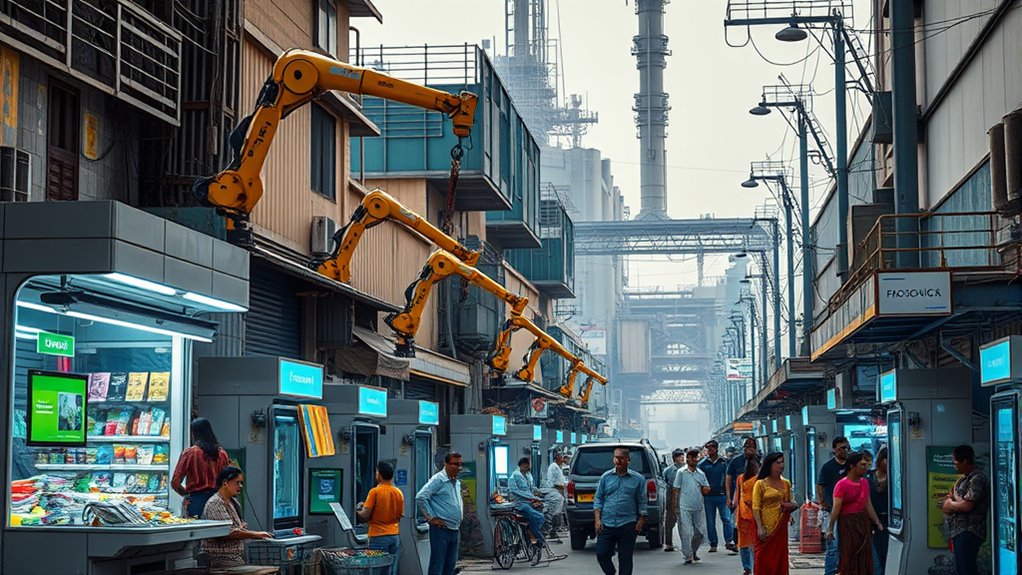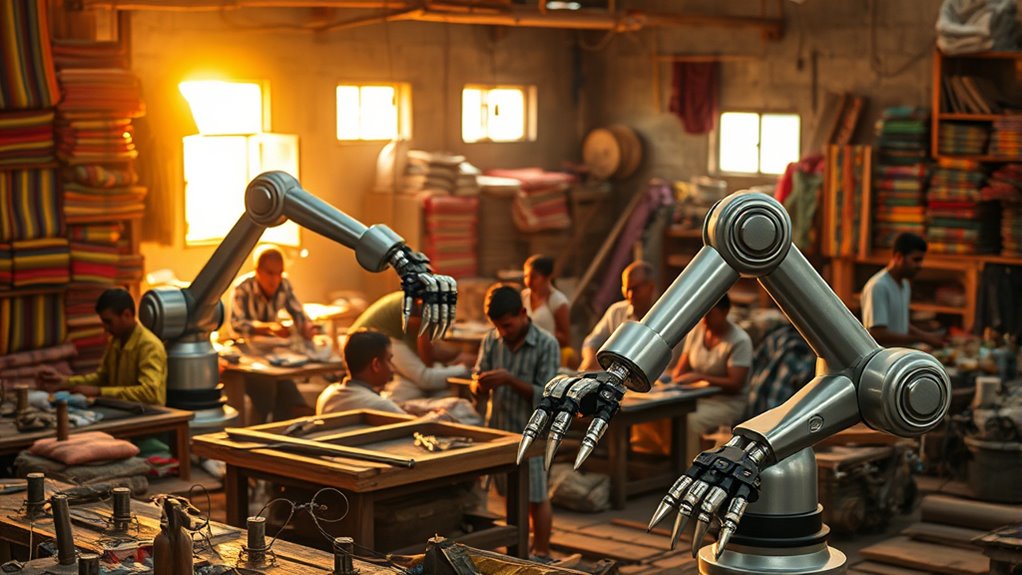Automation is transforming developing nations’ economies, boosting productivity but also risking greater inequalities if not managed well. Robots can help industries grow and modernize, but they might displace low-skilled workers and deepen regional divides. Governments and businesses must develop policies to support workforce reskilling and infrastructure growth. If you want to understand how these countries are balancing innovation with inclusion, there’s much more to explore below.
Key Takeaways
- Automation can boost productivity in developing countries but may exacerbate income inequality if benefits aren’t equitably shared.
- Infrastructure limitations and digital divides hinder robot deployment, potentially slowing technological progress in some regions.
- Public-private partnerships and targeted policies can help developing nations leverage automation for inclusive growth.
- Automation may displace low-skilled jobs, but reskilling and workforce development are essential for sustained economic rise.
- The rise of robots could either accelerate or stall development depending on access, investments, and regulatory frameworks.
The Global Impact of AI on Developing Economies

AI is transforming developing economies by integrating into key sectors like finance, healthcare, and agriculture, often despite limited resources. You’ll notice that even with infrastructure and digital literacy barriers, countries remain optimistic about AI’s potential—places like Indonesia and Thailand show high enthusiasm. Public-private partnerships drive pilot projects, creating localized AI solutions that address regional needs. While regional divides in digital access widen disparities, AI’s promise to boost productivity and economic growth remains strong. Experts estimate AI could add trillions to GDP worldwide, opening opportunities for leapfrogging traditional development stages. Moreover, AI technology adoption is accelerating rapidly in many developing countries, which could significantly alter their economic trajectories. This rapid adoption underscores the importance of developing predictive modeling techniques to forecast future needs and optimize resource distribution. Additionally, fostering digital literacy among populations is crucial to ensure equitable access to AI benefits. Governments are also exploring regulatory frameworks to guide responsible AI deployment and mitigate potential risks. Furthermore, investing in infrastructure development is essential to overcome connectivity challenges that hinder AI adoption. However, uneven access to power, data, and skilled labor pose challenges. If managed well, AI can accelerate growth, but without inclusive policies, it risks deepening existing inequalities.
Shifts in Manufacturing and Industrial Transformation

The manufacturing sector is experiencing a profound transformation driven by increased automation and technological innovation. Over 4 million robots now operate globally, boosting efficiency and productivity. AI integration is expanding rapidly, expected to reach $8.57 billion by 2025 with a 44.2% CAGR, shaping smarter manufacturing processes. Manufacturers are shifting toward localized supply chains to reduce risks and enhance resilience, a trend likely to continue. However, growing energy demands challenge sustainability efforts, pushing industries to focus on greener operations. Hybrid industries, combining traditional and advanced technologies, are outpacing others in growth, especially in the Asia Pacific region, which is expected to see significant gains. Meanwhile, process automation, though dominant, is growing at a slower pace, emphasizing the ongoing push for technological advancement across manufacturing. Additionally, the adoption of projector technology in manufacturing facilities for training and remote monitoring is becoming increasingly prevalent, supporting Industry 4.0 initiatives. The integration of self-watering plant pots concepts into factory environments exemplifies sustainable practices that can be adopted in industrial settings to optimize resource management. Furthermore, the adoption of personal development techniques such as goal setting and self-reflection can enhance workforce resilience and adaptability in rapidly changing industrial landscapes. Incorporating skilled labor training programs alongside automation efforts is essential to address the evolving skill requirements and ensure a balanced workforce.
The Rise and Risks of Service Industry Automation

As manufacturing industries embrace automation to boost efficiency and resilience, the service sector is experiencing a similar surge in technological adoption. You’ll find AI and robotics increasingly used in customer service, with chatbots and virtual assistants delivering faster, more consistent responses. Automated data processing helps manage large datasets, freeing up staff for strategic tasks, while healthcare systems use automation to improve diagnosis and patient care. Financial services rely on automation for transactions and analysis, reducing errors and speeding up processes. However, risks come with these gains. Job displacement, especially for low-skilled workers, is a concern. Dependence on technology can cause disruptions, and security issues raise data breach fears. Ethical questions about transparency and accountability also grow as automation becomes more embedded in service industries. Approximately 880 million people (12% of the world population) live in underdeveloped countries and many face challenges in adopting such advanced technologies due to infrastructural limitations and energy poverty. Limited infrastructure and energy access can hinder the deployment of advanced automation technologies, making it difficult for developing nations to keep pace with global trends.
Navigating Economic Disparities and Income Inequality

Automation can widen income gaps if its benefits aren’t shared fairly, leaving many workers behind. You need strong policies to prevent wealth from concentrating in the hands of a few. By implementing targeted interventions, developing countries can foster more equitable growth and reduce inequality. For example, integrating cultural intelligence into workplace engagement strategies can boost morale and foster a more inclusive environment, indirectly supporting social equity efforts. Additionally, promoting mindfulness principles in leadership can enhance decision-making processes, fostering a more compassionate approach to economic development. Recognizing personality traits that influence workplace dynamics can help tailor policies to better support diverse employee needs. Emphasizing community involvement can also strengthen social bonds and promote collective growth.
Widening Income Gaps
Widening income gaps pose a significant challenge for developing countries, especially as automation accelerates and reshapes labor markets. With two-thirds of the world’s population living in countries where inequality is growing, the divide between rich and poor widens. Economic stagnation during prolonged periods of slow growth or crisis, like COVID-19, pushes more people into poverty and deepens disparities. Automation displaces low-skill, routine jobs, making it harder for vulnerable workers to find stable employment. Countries with limited fiscal space struggle to implement redistribution policies, further fueling inequality. Public concern remains high, with more than half of people in many nations viewing the income gap as a major problem. As wealth concentrates at the top, economic and social divides threaten stability and social cohesion. High Gini coefficients in many developing nations highlight the extent of income inequality, which hampers sustainable growth and social development. Additionally, the concentration of wealth can hinder technological innovation that might otherwise benefit broader populations.
Policy Interventions Needed
Policy interventions are essential to address the economic disparities and rising income inequality resulting from automation. You need to support worker transition through reskilling programs, lifelong learning platforms, and expanded vocational training. Public-private partnerships can fund training initiatives and provide job placement services to help displaced workers find new roles in tech-driven sectors. Incentivizing inclusive automation investment with tax breaks, grants, and low-interest loans encourages socially beneficial automation. Building infrastructure like broadband, smart factories, and reliable energy supports sustainable automation growth. Implementing fair regulatory frameworks ensures worker protection, safety standards, and transparency. Additionally, risk insurance schemes and innovation hubs can promote experimentation and adaptation. These targeted policies help navigate the social impacts of automation, fostering equitable economic development and minimizing inequality. Emphasizing the importance of affordable and accessible available technology can further facilitate widespread adoption and benefit diverse communities. Incorporating innovative automation techniques can enhance productivity while maintaining job opportunities for local workforces. Recognizing the role of butter production and processing in local economies can guide tailored policy measures to support small-scale food producers and sustain regional employment. Furthermore, promoting inclusive growth strategies ensures that technological advancements benefit all segments of society, reducing the risk of deepening disparities.
Strategies for Workforce Development and Skills Enhancement

To guarantee developing countries can effectively harness automation’s benefits, they must prioritize workforce development and skills enhancement. You need to invest in education, focusing on STEM and vocational training, to build a skilled labor force capable of handling advanced technologies. Public policies should incentivize companies to invest in employee training through tax breaks and subsidies. Collaborating via public-private partnerships can maximize resources and expertise, expanding training opportunities. Emphasizing lifelong learning ensures workers stay adaptable amid technological changes. Strategies like apprenticeship models, seen in countries like Germany and Switzerland, offer practical experience. Additionally, developing skills in AI, digital tools, and green tech through targeted programs and innovative methods, such as online courses, will prepare your workforce for future demands. Technological innovation has been predicted to transform industries worldwide, underscoring the importance of proactive skill development.
Diversification: Moving Beyond Traditional Sectors

You can strengthen your economy by expanding into new industries and reducing reliance on manufacturing. Building a resilient service sector offers opportunities for job growth and economic stability. Embracing technological advances will help facilitate sectoral shifts and boost diversification efforts.
Expanding Into New Industries
Expanding into new industries offers developing countries a vital pathway to diversify their economies and reduce reliance on traditional sectors. By shifting focus, you can tap into knowledge-intensive services, digital platforms, and niche global value chains. This move helps you leverage global market trends and attract foreign direct investment through tax incentives. Countries like Moldova and Vietnam show success by reorienting from agriculture to manufacturing and services, boosting economic resilience. Digitalization strategies and learning-by-exporting enable you to upgrade capabilities and enter higher-value markets. However, technological changes and premature deindustrialization present challenges. You need to stay adaptable and informed about global shifts to effectively navigate this transition. Diversification through new industries can open doors to sustainable growth and economic stability.
- Focus on knowledge-intensive services and digital platforms
- Tap into global value chains for niche specialization
- Use tax incentives and FDI to attract investment
- Learn from regional success stories like Moldova and Vietnam
Reducing Manufacturing Dependence
Building on efforts to diversify economies through new industries, reducing reliance on manufacturing becomes a vital strategy for developing countries seeking stability and growth. Diversification helps you weather global commodity price swings, boosting economic stability. It also increases export earnings by expanding into multiple sectors, making your economy more resilient. By promoting efficient resource use, diversification encourages investments in diverse industries, enhancing your country’s competitiveness globally. It supports long-term sustainability, lowering dependence on a few sectors. However, challenges like limited access to advanced technology, infrastructure gaps, and a lack of skilled labor can slow progress. External market pressures and financial constraints also pose hurdles. With targeted development assistance—offering funding, expertise, and market access—you can overcome these barriers and create a more balanced, stable economy beyond traditional manufacturing.
Building Service Sector Resilience
Why is diversifying the services sector essential for developing countries aiming for economic resilience? A diverse services sector reduces dependence on traditional industries like agriculture or manufacturing, shielding your economy from external shocks. Expanding into subsectors such as telecommunications, financial services, and education promotes sustainable growth and stability. Developing logistics, freight transport, and certification services enhances integration into global value chains and broadens economic activity. Countries with diversified services tend to generate more employment and maintain a balanced economic structure.
- Digital transformation boosts productivity in information and telecom services.
- Technology supports export diversification beyond commodities.
- E-commerce, fintech, and online education create new opportunities.
- Investing in digital infrastructure fosters inclusive, resilient growth.
The Role of Augmentation Versus Automation in Growth

While both augmentation and automation drive economic growth, they play fundamentally different roles in shaping developing countries’ progress. Augmentation involves using technology to enhance human skills, making workers more efficient and creating new job opportunities. It boosts productivity, encourages economic diversification, and improves competitiveness. In contrast, automation replaces human labor with machines, which can lead to job displacement and widen inequality if not managed carefully. Automation might attract investment and improve export efficiency but risks reducing employment in traditional sectors. Successful growth depends on integrating both approaches: augmentation to develop a skilled workforce and automation to boost productivity. By focusing on augmentation, developing countries can elevate their industries and foster sustainable, inclusive growth without sacrificing employment opportunities.
Challenges to Long-term Development Goals

Achieving long-term development goals in developing countries faces significant hurdles due to limited access to automation technologies. You encounter challenges like high costs, which make deploying automation difficult without substantial investment. Infrastructural gaps and a shortage of skilled workers further slow adoption, creating a digital divide that deepens socio-economic inequality. You also face difficulties in developing policies that ensure equitable benefits, risking increased disparities.
- Limited capital and investment restrict automation deployment
- Insufficient infrastructure and expertise hinder progress
- Widening digital divide amplifies socio-economic gaps
- Lack of inclusive policies hampers equitable growth
Opportunities for Innovation and Economic Resilience

Innovation in local digital ecosystems offers significant opportunities to boost economic resilience in developing countries. By expanding digital industries, you can help regions adapt more quickly to economic shocks and market fluctuations. The projected AI-driven contribution of US$15.7 trillion to global GDP by 2030 highlights the vast potential for growth through innovation. Developing nations can diversify their economies beyond traditional sectors like manufacturing and agriculture, leveraging automation to create new digital industries. Strengthening digital infrastructure, skills, and entrepreneurial ecosystems enables communities to respond better to global uncertainties. Additionally, data analytics and technological adoption improve resource allocation and productivity, making economies more robust. Embracing these opportunities positions developing countries to build resilient, sustainable growth paths amid ongoing technological transformation.
Policy Approaches for Inclusive Technological Adoption

To guarantee that developing countries fully benefit from automation and digital growth, effective policy approaches are necessary to promote inclusive technological adoption. You need targeted subsidies that lower costs for small and medium enterprises, making automation accessible. Incentives for upskilling workers ensure the labor force adapts to new technologies. Regulatory sandboxes allow safe testing of emerging automation solutions, encouraging innovation. Strong data governance policies foster transparency and build trust. Additionally, public sector investments in digital infrastructure provide essential platforms for businesses to grow. Public-private partnerships can pool resources, while collaborative training programs develop local skills. Flexible labor regulations and social protections help workers transition smoothly. Local capacity building and ongoing evaluation guarantee policies remain effective and inclusive, maximizing benefits for all stakeholders.
Frequently Asked Questions
How Can Developing Countries Leverage AI for Inclusive Economic Growth?
You can leverage AI in developing countries by tailoring solutions to local needs and infrastructure, making them affordable with declining costs. Investing in digital literacy, fostering local innovation, and building strong policies will boost inclusive growth. Connecting underserved communities to markets through digital platforms and supporting small businesses with AI tools creates opportunities. By focusing on infrastructure and skills, you guarantee AI benefits everyone, reducing inequalities and driving sustainable economic progress.
What Are Effective Policies to Prevent Ai-Driven Job Inequality?
To prevent AI-driven job inequality, you should implement policies that promote education and skills development, especially in STEM and digital literacy. Expand social safety nets like unemployment benefits and explore universal basic income trials. Support workforce transitions through training and counseling, and protect gig workers’ rights. Encouraging local innovation, diversifying economies, and fostering international cooperation will help you create an inclusive environment where AI benefits everyone equally.
How Will AI Affect Informal and Small-Scale Industries in Developing Nations?
Think of AI as a double-edged sword, cutting through the fog of informal work with digital clarity. You’ll see it boost visibility for informal workers, help them access wider markets, and create portable reputations. But it also risks displacing small-scale industries, automating tasks once done by hand. Your challenge is to harness AI’s potential to uplift, while managing its disruptive force, ensuring these industries thrive in a digitally connected world.
What Role Does Education Play in Preparing Workers for Ai-Driven Changes?
You play a essential role in preparing workers for AI-driven changes through education. By investing in STEM and AI-specific curricula, you equip people with digital literacy and practical skills needed for emerging jobs. Promoting reskilling and upskilling programs ensures workers adapt to new technologies. Additionally, fostering collaborations among government, industry, and educational institutions helps create accessible learning opportunities, making sure everyone can thrive in an AI-powered economy.
Can AI Help or Hinder Long-Term Sustainable Development Goals?
You might think AI will hinder sustainable development, but it actually has great potential to help. It accelerates progress by improving healthcare, optimizing agriculture, and boosting energy efficiency. However, risks like widening inequalities and data privacy issues exist if it’s poorly managed. To truly benefit, you need strategic policies, capacity building, and ethical standards—ensuring AI supports long-term goals rather than stalls them.
Conclusion
As robots reshape industries worldwide, it’s ironic how developing countries might find both opportunity and challenge in this tech surge. While automation could deepen disparities, it also offers a chance to leapfrog traditional development stages. By embracing strategic policies and skills training, you can turn these coincidences into catalysts for growth. Ultimately, your proactive approach determines whether automation becomes a barrier or a bridge to a more inclusive, resilient future.









